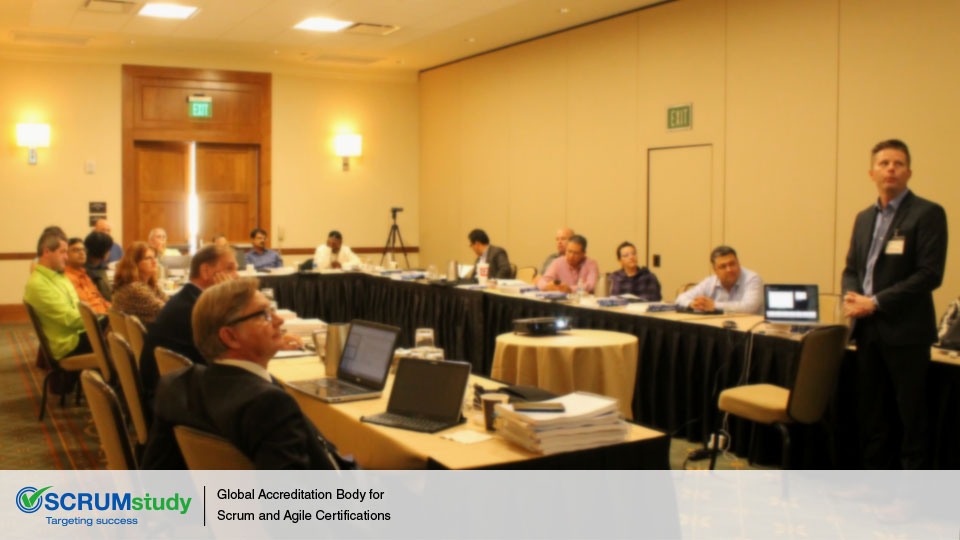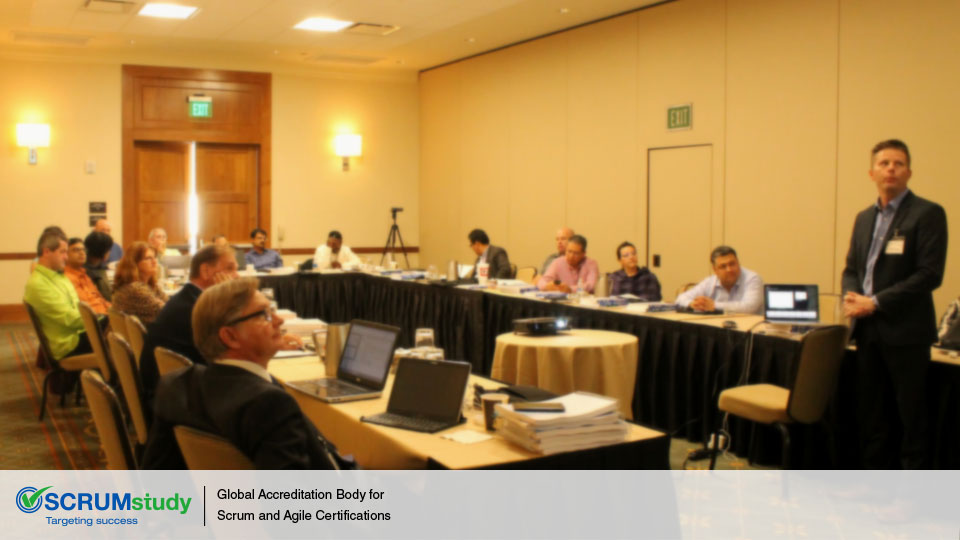Scrum Agile Product Backlog
Posted bySCRUMstudy® on June 06, 2024
Categories Agile Product Backlog Product Owner SBOK® Guide Scrum Scrum Guide Scrum Master Scrum Team
The Scrum Product Backlog is a vital component of the Scrum framework, serving as a dynamic, prioritized list of tasks and features that are essential for achieving the project's goals. Managed by the Product Owner, it ensures that the development team focuses on the most valuable and high-priority items first.
A typical Prioritized Product Backlog will contain all User Stories, their time estimates (including any revised estimates), and the status of higher priority requirements. Any new or revised User Stories resulting from changes to business requirements, customer requests, external market conditions, and/or lessons learned from previous Sprints are also incorporated.
Product Backlog Review Meeting
Aalso referred to as a Prioritized Product Backlog Refining Session is a formal meeting during the Refine Prioritized Product Backlog process, which helps the Scrum Team review and gain consensus about the Prioritized Product Backlog. However, other than the Prioritized Product Backlog Review Meeting, Prioritized Product Backlog refining should happen throughout the project and can include situations in which the Product Owner writes new User Stories or reprioritizes User Stories in the existing Prioritized Product Backlog, Scrum Team members or business stakeholders give their suggestions about new User Stories to the Product Owner, and so forth.
Backlog Refining Session
The Product Owner takes the lead in a Product Backlog Review Meeting which is conducted during the Refine Prioritized Product Backlog process. It is important that the Product Owner sets the objectives and ideally develop an agenda before the Product Backlog Review Meeting begins. Without these, the session will be unstructured and may prove unproductive. It is also important to limit the number of business stakeholders participating in the meeting. Having too many participants tends to decrease the overall efficiency of the meeting. The Product Owner should invite only those business stakeholders whose feedback is required for the refining session. All Scrum Team members should be included because their input is valuable to the work being done and any issues encountered. If the refining session results in any reprioritization of or change in the Prioritized Product Backlog, it is important that the team is in agreement with those changes.
Backlog Refining Techniques
- Develop Epic(s)
- Create Prioritized Product Backlog
- Conduct Release Planning
- Create User Stories
- Estimate User Stories
- Commit User Stories
- Identify Tasks
- Estimate Tasks
Refining helps ensure that refining of requirements and their User Stories is done well in advance of the Sprint Planning Meeting so that the team has a well-analyzed and clearly defined set of stories that can be easily broken down into tasks and subsequently estimated.
Based on lessons learned from the current Sprint, there may be changes to requirements, or there may be reprioritization that can be easily incorporated into subsequent Sprints. Refining supports and enhances the flexibility of the Scrum model by incorporating the latest business and technical insights into future Sprints.
Scrum Agile Product Backlog
Posted bySCRUMstudy® on May 07, 2024
Categories Agile Product Backlog Product Development Product Owner Scrum
The Scrum Agile Product Backlog, as detailed in the SBOK® Guide (Scrum Body of Knowledge), is a prioritized list of features, enhancements, bug fixes, and technical tasks that serves as the single source of work for the Scrum Team. Managed by the Product Owner, the backlog is dynamic, constantly evolving to incorporate new insights, market changes, and stakeholder feedback. Each item in the backlog, known as a Product Backlog Item (PBI), is typically detailed with descriptions, priority levels, and estimates. This structured and flexible approach ensures that the team focuses on delivering the highest value features first, facilitating adaptive planning and incremental delivery.
The Scrum Agile Backlog is a prioritized list of all the work that needs to be done to complete a project. It contains user stories, features, bug fixes, technical tasks, and any other work items necessary for delivering a product increment. The backlog is dynamic, evolving as requirements change or new insights emerge. It is managed and prioritized by the Product Owner, who ensures that the most valuable items are at the top.
The Prioritized Product Backlog is a single requirements document that defines the project scope by providing a prioritized list of features of the product or service to be delivered by the project. The required features are described in the form of User Stories.
User Stories are specific requirements outlined by various business stakeholders as they pertain to the proposed product or service. Each User Story will have associated User Story Acceptance Criteria (also referred to as “Acceptance Criteria”), which are the objective components by which a User Story’s functionality is judged. Acceptance Criteria are developed by the Product Owner according to his or her expert understanding of the customer’s requirements. The Product Owner then communicates the User Stories in the Prioritized Product Backlog to the Scrum Team members and their agreement is sought.
Acceptance Criteria should explicitly outline the conditions that User Stories must satisfy. Clearly defined Acceptance Criteria are crucial for timely and effective delivery of the functionality defined in the User Stories, which ultimately determines the success of the project.
At the end of each Sprint, the Product Owner uses these criteria to verify the completed deliverables; and can either accept or reject individual deliverables and their associated User Stories. If deliverables are accepted by the Product Owner, then the User Story is considered Done. A clear definition of Done is critical because it helps clarify requirements and allows the team to adhere to quality norms. It also helps the team think from the user’s perspective when working with User Stories.
Scrum Agile Product Backlog
Posted bySCRUMstudy® on January 16, 2024
Categories Agile Product Backlog Product Development Product Owner Scrum
El Backlog de Producto Scrum Agile, como se detalla en la Guía SBOK ® (Scrum Body of Knowledge), es una lista priorizada de características, mejoras, correcciones de errores y tareas técnicas que sirven como única fuente de trabajo para el equipo Scrum. Gestionado por el propietario de productos, el retraso es dinámico, evolucionando constantemente para incorporar nuevas perspectivas, cambios de mercado y retroalimentación de los interesados. Cada artículo en el retraso, conocido como un artículo Backlog del Producto (PBI), se detalla típicamente con descripciones, niveles de prioridad y estimaciones. Este enfoque estructurado y flexible garantiza que el equipo se centre en la entrega de las características más altas de valor primero, facilitando la planificación adaptativa y la prestación gradual.
El Scrum Agile Backlog es una lista prioritaria de todo el trabajo que hay que hacer para completar un proyecto. Contiene historias de usuarios, características, correcciones de errores, tareas técnicas y cualquier otro material de trabajo necesario para la entrega de un incremento del producto. El retraso es dinámico, evolucionando a medida que cambian los requisitos o surgen nuevas perspectivas. El Producto lo gestiona y prioriza, quien asegura que los objetos más valiosos están en la parte superior.
El Backlog del Producto Priorizado es un documento único de requisitos que define el alcance del proyecto proporcionando una lista prioritaria de características del producto o servicio que debe entregar el proyecto. Las características requeridas se describen en forma de Historias de Usuario.
Las historias de usuarios son requisitos específicos descritos por diversos interesados empresariales en lo que respecta al producto o servicio propuesto. Cada Historia del Usuario tendrá los criterios de aceptación de historias de usuarios asociados (también conocidos como “Criterios de Aceptación”), que son los componentes objetivos por los que se juzga la funcionalidad de una Historia de Usuario. Los criterios de aceptación son desarrollados por el propietario del producto según su pericia comprensión de los requisitos del cliente. El Producto comunica a los miembros del equipo Scrum las historias de usuarios en el Backlog del Producto Priorizado y se busca su acuerdo.
Los criterios de aceptación deben describir explícitamente las condiciones que deben cumplir las Historias de Usuario. Los criterios de aceptación definidos claramente son cruciales para la entrega oportuna y eficaz de la funcionalidad definida en las Historias de Usuario, que determinan en última instancia el éxito del proyecto.
Al final de cada Sprint, el Producto Product utiliza estos criterios para verificar los entregables cumplidos; y puede aceptar o rechazar los entregables individuales y sus Historias de Usuario asociadas. Si los entregables son aceptados por el Producto Producto, entonces la Historia del Usuario se considera Hecho. Una definición clara de Hecho es fundamental porque ayuda a aclarar los requisitos y permite al equipo cumplir las normas de calidad. También ayuda al equipo a pensar desde la perspectiva del usuario cuando trabaja con Historias de Usuario.



